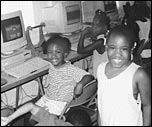Bringing the Classroom to the Community
Faculty, Students Use Service-Learning to Address Real-Life Challenges
By D. Lyn Hunter, Public Affairs
Posted April 28, 1999
 Youngsters from West Oakland use the computer lab at the STEP community center. The center was created by Berkeley student Chris Martinez as a service-learning class project. |
This teaching method, commonly known as service-learning, actively engages students in the learning process by having them identify an issue or problem in the community, research the problem, craft a solution utilizing the theories and concepts of an academic course, work with community members to implement the solution and then evaluate the process.
"Learning needs context and authenticity," said Andrew Furco, director of Berkeley's Service-Learning Research and Development Center. "With service learning, students can apply the theories they've learned in the classroom to address real-life situations while benefiting the community."
Service-learning can be used in almost any academic discipline. For example, students in Scandinavian studies collected oral histories from elderly members of a local Finnish community, recording activities from the early 1900's to the present. Engineering students have worked with organizations that serve the physically disabled to design helpful technology.
John Hurst, professor of social and cultural studies in education, has used community learning in his courses since the early 1970s. Over the years, Hurst, who recently won the first-ever Chancellor's Award for Outstanding Service-Learning Faculty, has developed and initiated a number of campus courses and programs that continue to flourish today and serve as models for universities across the country.
One such project is the Student Tutorial Endeavor Program (STEP), created by Chris Martinez, a student in Hurst's "Current Issues in Education" course. The STEP program provides mentors and tutors for low-income children in Martinez' West Oakland neighborhood.
The project started two years ago with 20 kids in a one-room facility. It now serves 150 youths, occupies three floors, including a computer lab and library, and has a $250,000 annual budget. It also provides opportunities for more than 70 Berkeley students each semester who volunteer in exchange for units. It also gives Martinez the chance to use the concepts and theories he's learned in the classroom to help solve social problems.
"Most of these children are behind academically and receive a lot of peer pressure to take drugs," said Martinez, a 23-year-old history major. "By collaborating with their parents and teachers, local merchants and law enforcement, we've really come a long way."
Martinez, who is graduating this spring, said his service-learning project has been the highlight of his college career. "I've seen first hand the positive influence my fellow students and I can have on the community."
"One of the central goals of higher education, especially in a public university is to educate young people to be responsible, democratic citizens committed to the public good," said Hurst. One way for students to realize this goal, he says, is to "contribute to the understanding and solution of problems and issues confronting society."
While more than 150 service-learning courses are currently taught on campus, some faculty are reluctant to use service learning, said Furco. "Some professors think service learning means picking up trash in the community."
Because service-learning is a practical application as opposed to theoretical, certain faculty are concerned that it "dumbs down" the curriculum, said Furco. Junior faculty worry that integrating community service field work in their courses may hurt their chances for tenure in the campus' research-based climate.
"We see this as an enhanced delivery of curriculum," said Furco. "The data collected from service-learning projects can be used for research, thereby integrating the theoretical and practical sides of academia."
Furco works to dispel misunderstandings about service-learning by inviting faculty to attend informational forums where professors who use service-learning testify to the academic legitimacy and advantages of such programs.
Nationally, service-learning is becoming recognized as a teaching strategy that helps students build upon their course work. A three-year study conducted by the Rand Corporation found that college students in service-learning courses enjoyed their classes more and faculty found their papers and discussions to be more profound than non-service-learning students, according to Furco. The Service Learning Center is currently engaged in a number of national, state and local research studies to explore the impact of service-learning on students, faculty and schools.
For information on service-learning call Sally Russell at 642-3199.
![]()
![]()
April 28 - May 4, 1999 (Volume 27, Number 32)
Copyright 1999, The Regents of the University of California.
Produced and maintained by the Office of Public Affairs at UC Berkeley.
Comments? E-mail berkeleyan@pa.urel.berkeley.edu.